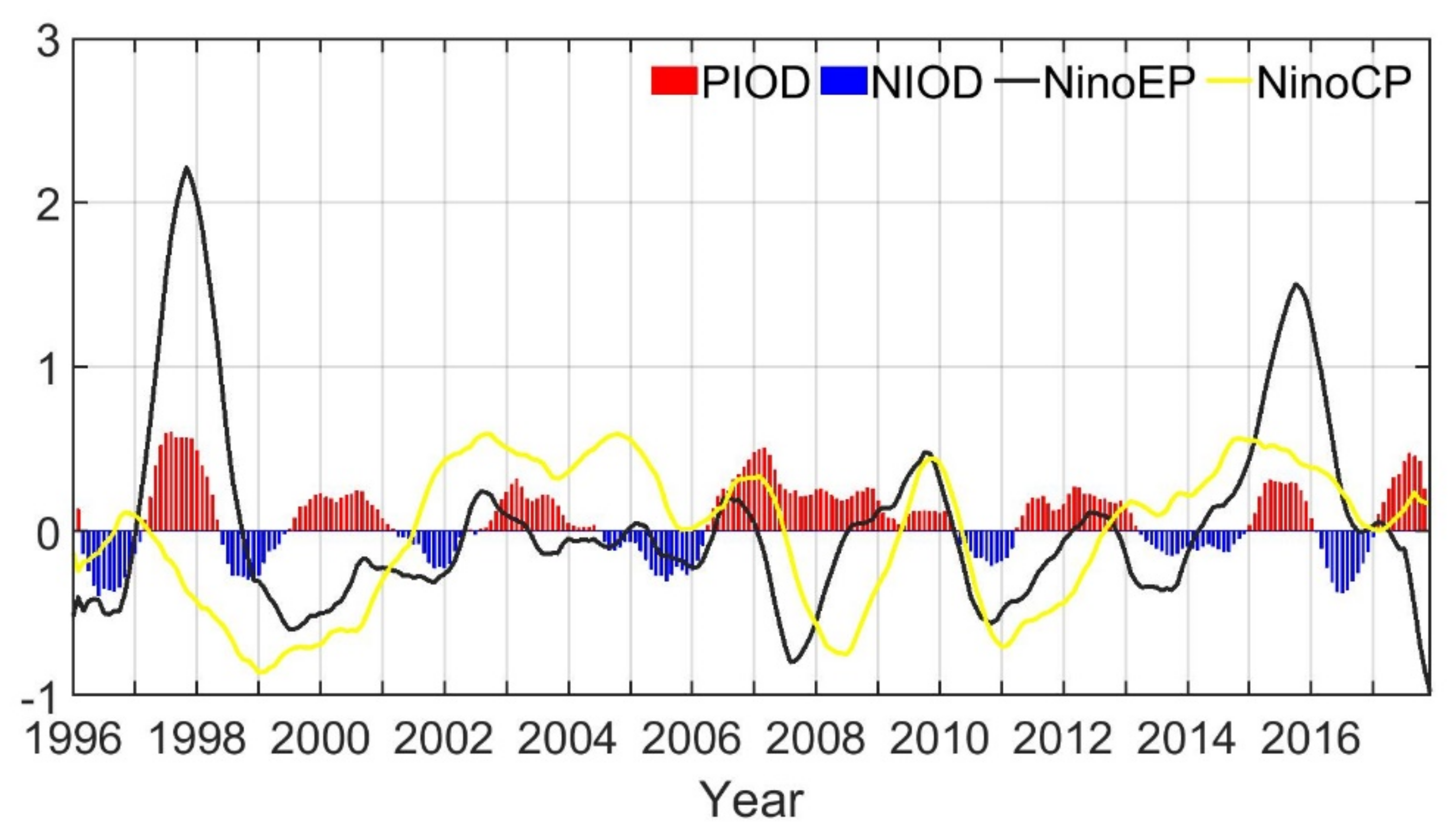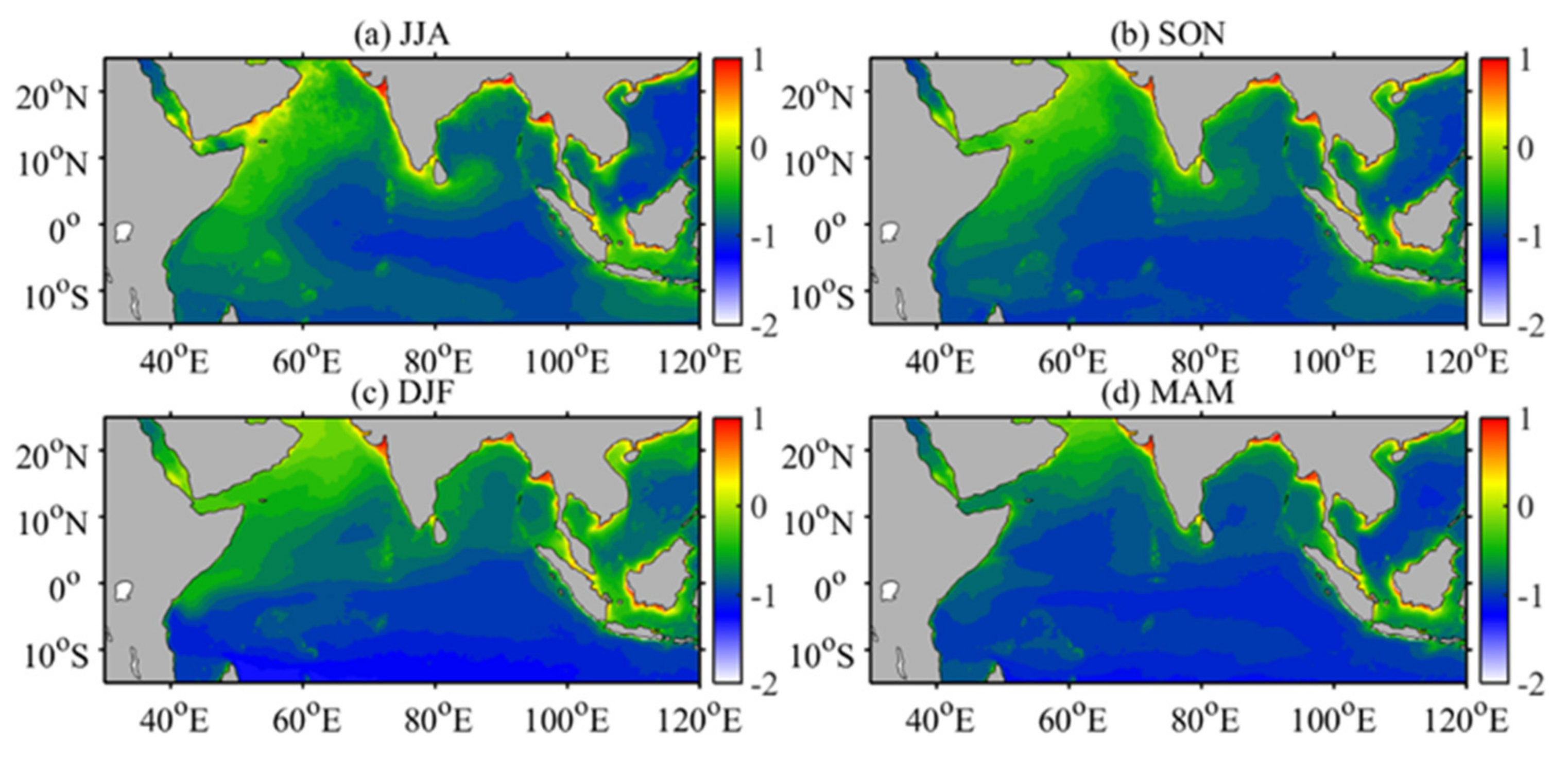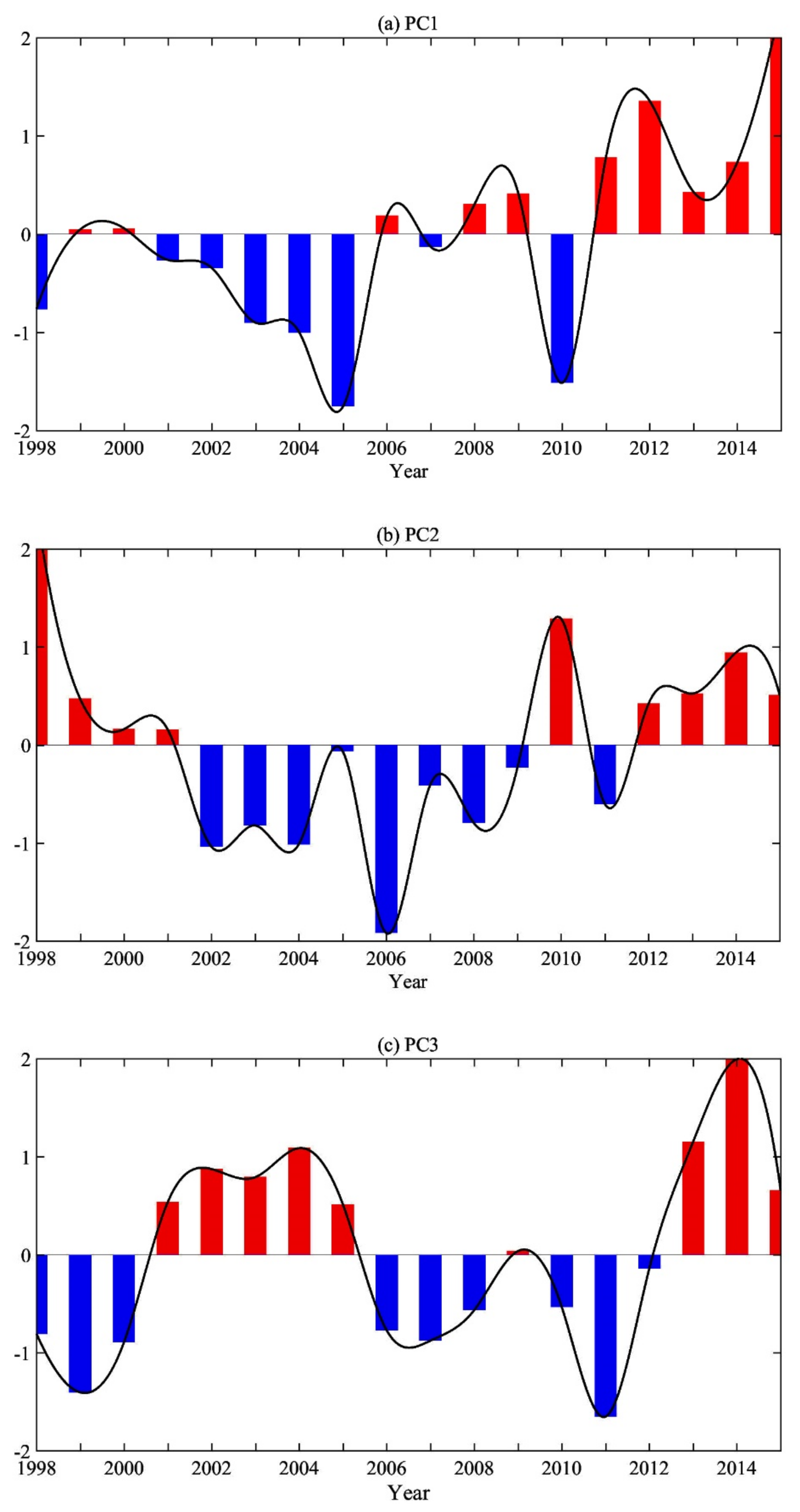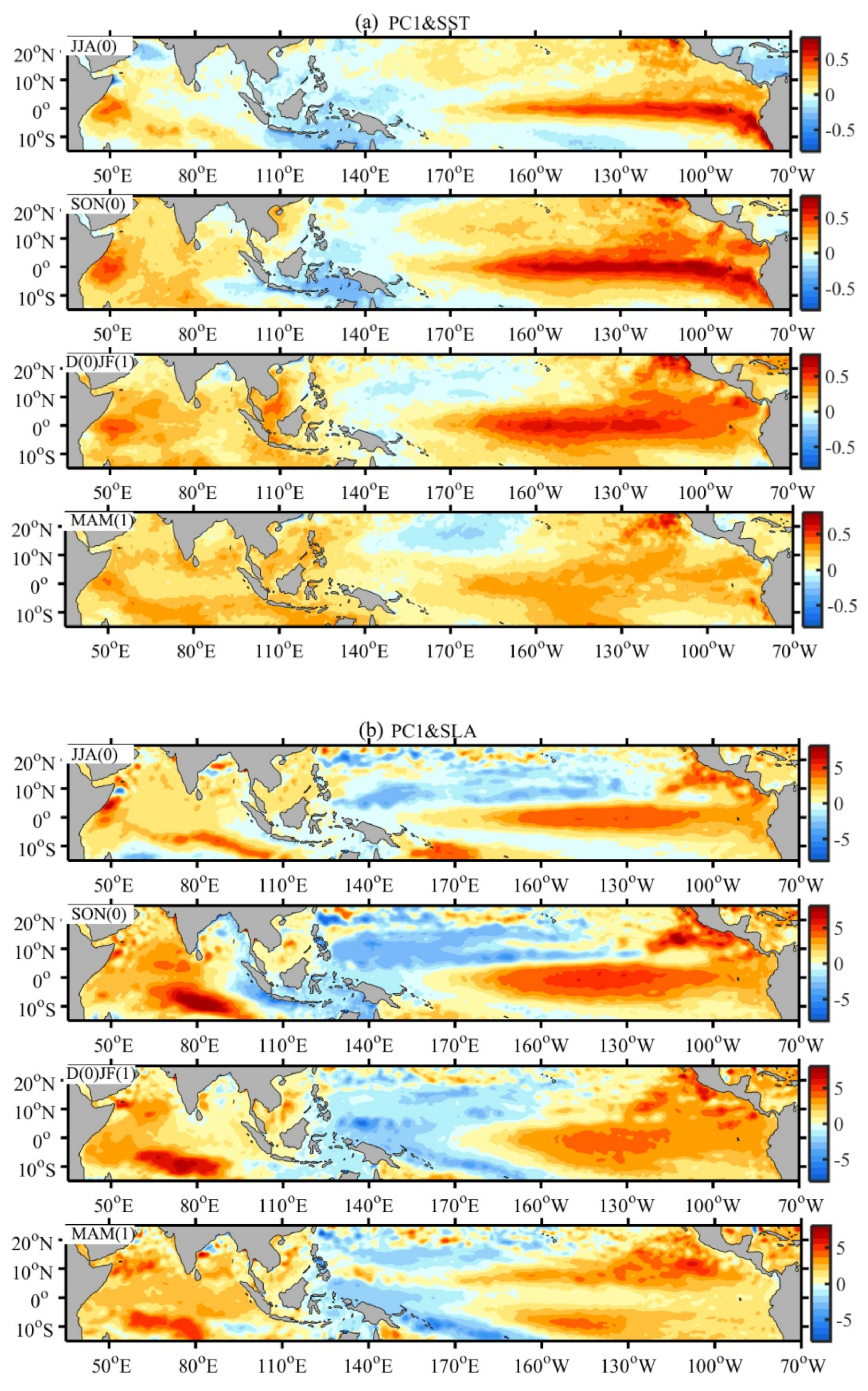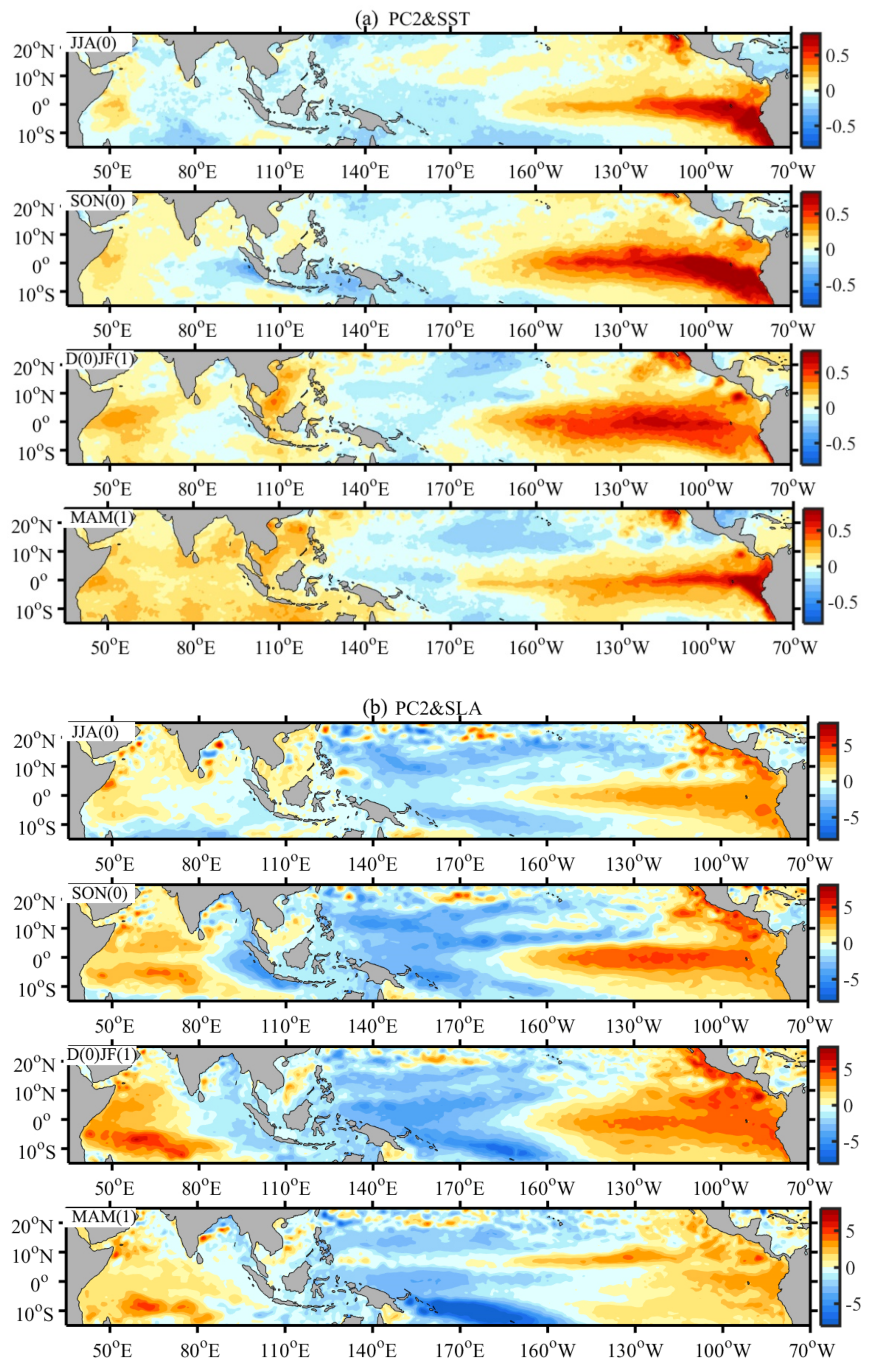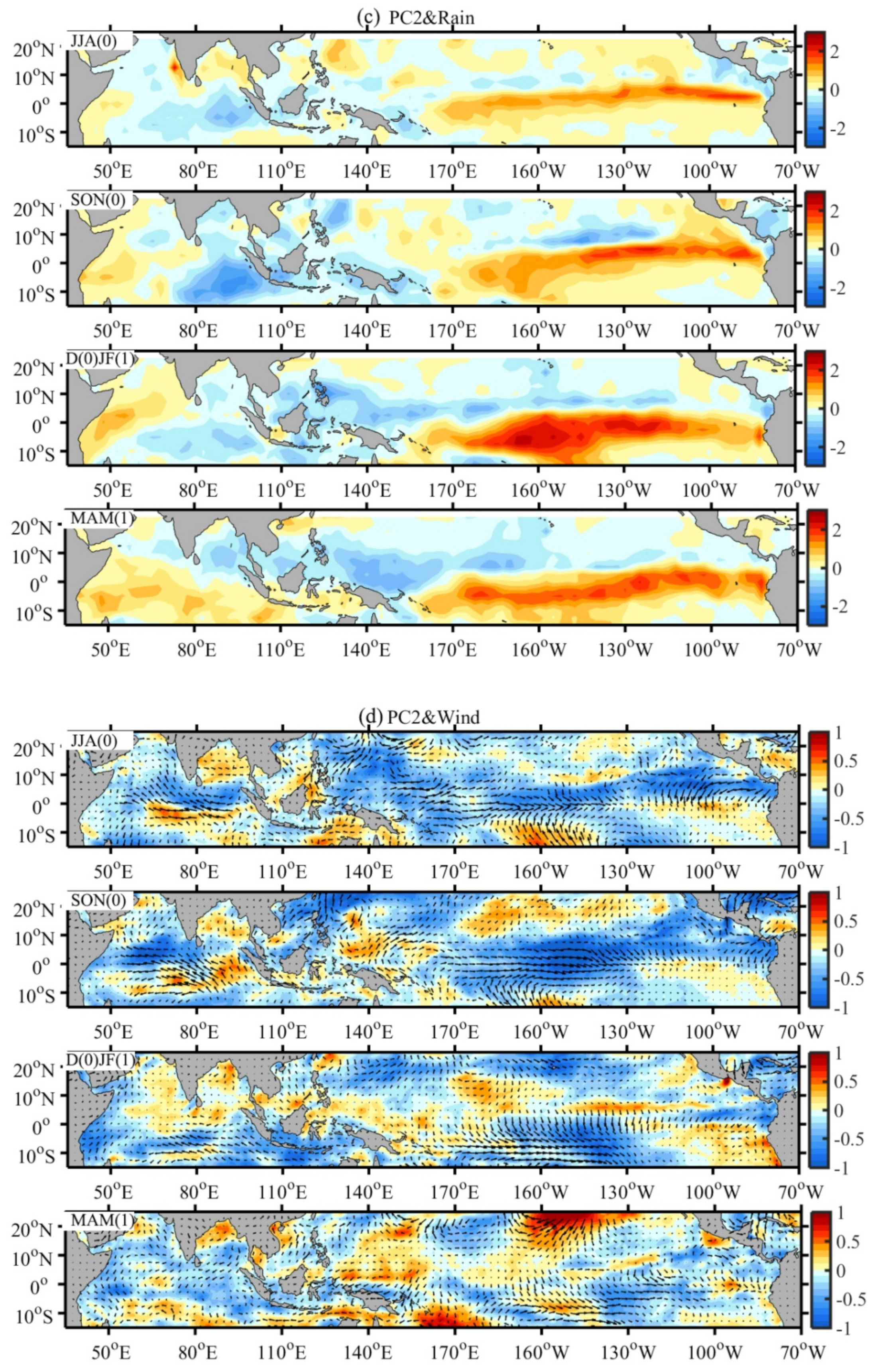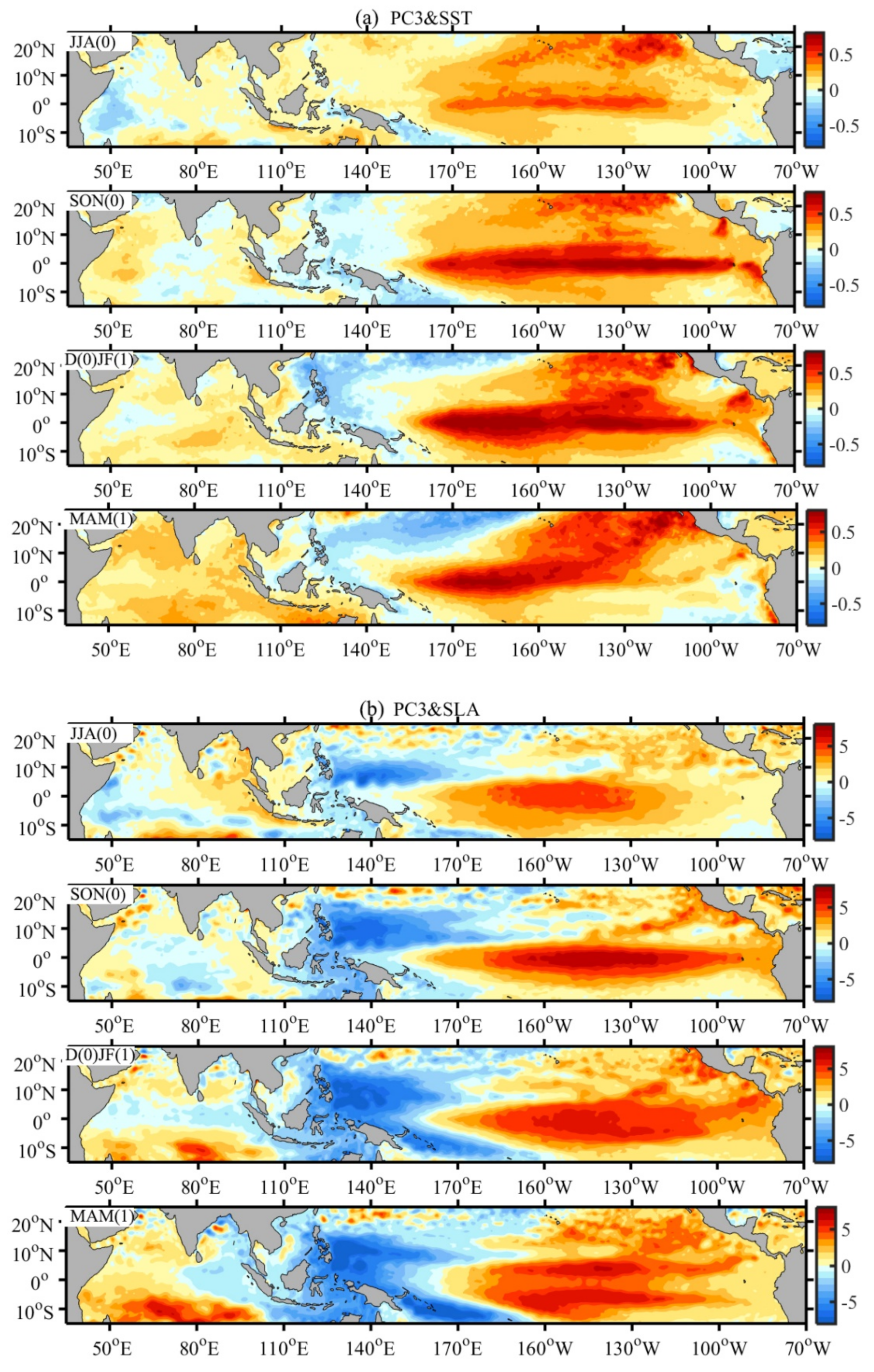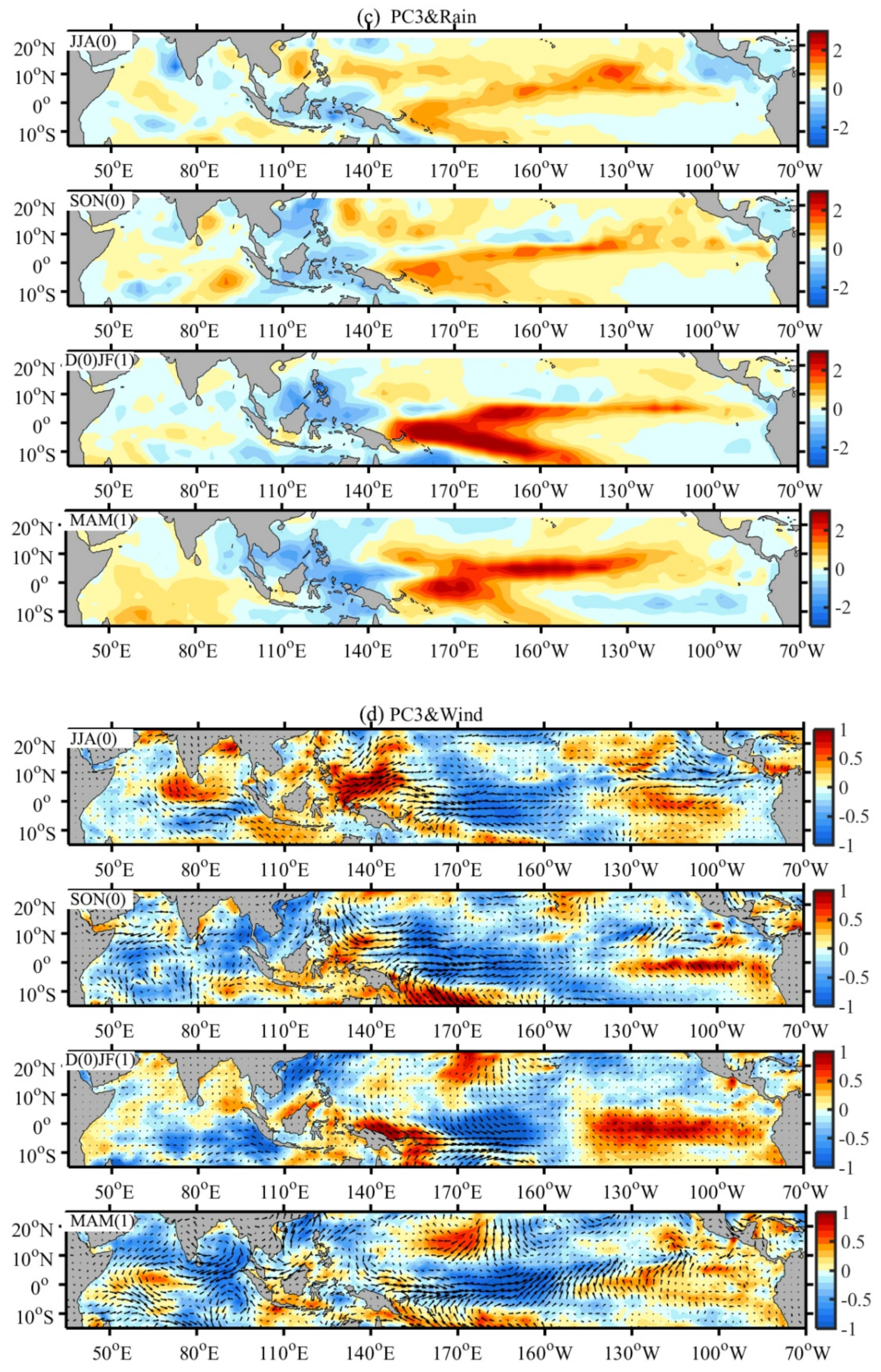3.1. Dominant Seasonal Evolution Patterns of Chla in the North Indian Ocean
The seasonal climate distribution of Chla in the northern Indian Ocean during the years 1998–2016 is shown in
Figure 2. It can be seen that the high-value Chla area is mainly concentrated in the western and northern Indian Ocean, and there is a significant seasonal shift in the high-value area, while the central and southern equatorial regions are always low.
The S-EOF analysis was performed on the seasonal anomaly sequence of Chla from 1998 to 2016, and the first three modes with physical significance were obtained. The variance contribution rates were 18.28%, 14.54%, and 7.68%, respectively, and the total variance contribution rate was 40.5%. Fourier transform-based power spectrum analysis was performed on the corresponding time series of principal components (PCs). The spatial mode (S-EOF), PC, and power spectrum analysis results are shown in
Figure 3,
Figure 4 and
Figure 5. The first three modes reflect the main characteristics of the interannual variation of Chla in the northern Indian Ocean, along with the seasonal evolution.
The spatial pattern of S-EOF1 (
Figure 3a) shows that Chla in the northern Indian Ocean was dominated by negative anomalies on the whole, and significant positive anomalies were detected along the Java–Sumatra coasts, and both positive and negative Chla anomaly centers and intensity varied greatly with seasons. It is very different from the seasonal climate distribution of Chla (high values are concentrated in the western and northern Indian Ocean in
Figure 1), indicating the significant interannual variation characteristics of this mode. In the boreal summer (
Figure 3a, JJA(0)), positive and negative Chla anomalies began to appear in the Java–Sumatra and central western Indian Ocean waters, respectively. In the boreal autumn (
Figure 3a, SON(0)), the Chla variation increased, and the intensity and range of the negative anomaly reached the maximum. In the boreal winter and spring (
Figure 3a, D(0)JF(1), MAM(1)), the Chla intensity of the negative anomaly weakened and the positive range increased.
Figure 3b shows the spatial pattern of S-EOF2 with significant positive seasonal Chla variation in the central Indian Ocean, and the negative anomaly centers mainly appear in the western Arabian Sea and the Java–Sumatra coasts. During the boreal summer (
Figure 3b, JJA(0)), the positive Chla anomaly began to appear in the western equatorial Indian Ocean, the southern Indian Peninsula, the waters near Sri Lanka, and the central Indian Ocean at the latitude of 10° S. The significant negative anomaly centers were distributed in the central Arabian Sea and the Java–Sumatra coastal waters. During the boreal autumn (
Figure 3b, SON(0)), the positive Chla anomaly increased significantly, while the negative anomaly intensity and range reached the maximum along the Java–Sumatra coasts. During the boreal winter (
Figure 3b, D(0)JF(1)), the Chla continued to rise, maximizing the range and intensity of the positive anomalies.
Meanwhile, the spatial pattern of S-EOF3 (
Figure 3c) features a dipole distribution, with a positive anomaly in the western Indian Ocean, a negative anomaly along the coast of the Java–Sumatra island in the 10° S latitude zone, and the intensity of the positive anomaly was significantly higher than that of the negative anomaly. The seasonal variation of Chla is relatively complicated. In the boreal summer (
Figure 3c, JJA(0)), the significant positive anomaly of Chla occurred in the western equatorial Indian Ocean, and the significant negative anomaly occurred in the northwestern Arabian Sea. In the boreal autumn (
Figure 3c, SON(0)), the negative anomaly intensity of Chla decreased, and its center moved southward in the Arabian Sea, while the negative anomaly in the Java–Sumatra coast moved northward, and the positive anomaly intensity decreased in the western equatorial Indian Ocean and moved eastwards to the central equatorial Indian Ocean.
To summarize, the S-EOF1 pattern shows that Chla, on the whole, features mostly negative anomalies and varies greatly with seasons, with obvious positive anomalies detected off the Java–Sumatra coasts. The negative and positive anomalies appeared separately in the central western Indian Ocean and the Java–Sumatra coasts during the boreal summer, with the maximum variability observed in the boreal autumn. A tripolar structure, with positive anomalies located in the central Indian Ocean and surrounded by two negative anomalies in the northwest and southeast, is recorded in the S-EOF2 pattern. Both positive and negative anomalies developed remarkably with the seasons and peaked in the boreal winter and autumn, respectively. The S-EOF3 pattern features a dipole distribution with a positive anomaly in the central west and a negative anomaly in the southeast, on the whole, accompanied by a relatively complex variability transition from an east–west to a north–south anomaly with seasons.
Figure 4 shows a time series of the principal components, and the magnitude of the absolute value reflects the strength of the variation. The greater the absolute value is, the stronger the variation is at that moment and the more typical the spatial distribution pattern is. In addition, if the time coefficient is negative, it means that the spatial distribution pattern of the moment is opposite to that shown in the figure. As shown in
Figure 4a, the time coefficients of PC1 are all negative from 1998 to 2005, except in 1999 and 2000, and positive from 2006 to 2015, except in 2007 and 2010. Among them, the negative values in 2005 and 2010 and the positive values in 2012 and 2015 are the most prominent. The results show that the Chla in the northern Indian Ocean had strong variation during these four years. 2015 was a year of strong El Nino and positive IOD events. Together with
Figure 3a (SON(0)), it can be seen that the Chla in the northern Indian Ocean presents a typical dipole variation structure with negative anomalies in the central west and positive anomalies in the east, indicating that the simultaneous occurrence of El Nino and positive IOD events strengthened the inter-annual variation of the Chla in the northern Indian Ocean. However, the time coefficient of 2012 is smaller than that of 2015, indicating that the dipole variation structure was weaker than that of 2015, mainly because 2012 was a year of strong positive IOD events and weak La Nina events, and La Nina events may have weakened the Chla variation intensity in the northern Indian Ocean. Similarly, the time coefficient in 2005 was significantly negative, indicating that the Chla in the northern Indian Ocean experienced a variation structure opposite to that in
Figure 3a (SON(0)), that is, the Chla in the central and western Indian Ocean was positively abnormal, and the Chla in the Java–Sumatra coast was negatively abnormal, which positively corresponds to the negative IOD events in 2005. The absolute value of the time coefficient in 2010 is smaller than that in 2005, and the interannual variation at this time was also smaller than that in 2005, while 2010 was a year of negative IOD and strong La Nina events, which also indicates that the occurrence of La Nina events weakened the varying intensity of the Chla in the northern Indian Ocean. In conclusion, the first main mode of the Chla change in the northern Indian Ocean is the one closely associated with the IOD and ENSO events.
PC2 shows negative anomalies from 2002 to 2011 (except 2010), positive anomalies from 1998 to 2001 and from 2012 to 2015 (
Figure 4b). Among them, the most prominent time coefficients are positive anomalies from 1998 and 2010 and negative anomalies from 2006. In 1998, the time coefficient reached the maximum, and the spatial distribution generally shows a positive anomaly of Chla in the central Indian Ocean and a negative anomaly in the western Arabian Sea and the Java–Sumatra coast (
Figure 3b), while 1998 had a negative IOD and La Nina event year. The results show that the simultaneous occurrence of the negative IOD and La Nina events led to a significant increase in the Chla in the central Indian Ocean and a significant decrease in the western Arabian Sea and the Java–Sumatra coast. The year 2010 also had negative IOD and La Nina events, and the above abnormal Chla also occurred, but the intensity was weaker than that of 1998. Similarly, the 2006 negative anomaly shows a decrease in Chla in the central Indian Ocean and an increase along the Java–Sumatra coast. It is shown that the second main mode is also the interannual variation mode associated with the IOD and ENSO events.
The variation characteristics of negative anomalies from 1998 to 2000, positive anomalies from 2001 to 2005, negative anomalies from 2006 to 2012 (except 2009), and positive anomalies from 2013 to 2015 are presented in
Figure 4c. The time coefficient values are most significant in 1999, 2011 (negative anomaly), and 2014 (positive anomaly). The year 2014 had positive IOD and El Nino events. In the boreal autumn, the Chla increased (positive anomaly) in the central equatorial Indian Ocean, and in the boreal winter, the Chla significantly increased in the equatorial belt of the western Indian Ocean. In 2011 (positive IOD and La Nina event years), the time coefficient is significantly negative, and the spatial structure of abnormal Chla in the northern Indian Ocean is opposite to that shown in
Figure 3c, that is, in the boreal winter, the Chla in the equatorial belt of the western Indian Ocean mainly decreased significantly (negative anomaly). Contrary to the spatial structure of 2014 (positive IOD and El Nino event year), this indicates that ENSO events had a greater influence on the mode, and the third main mode can be considered as the mode associated with ENSO events.
The power spectrum analysis of the time coefficient PC1 shows that the first mode mainly had intra-seasonal oscillation for a period of 6 months and interannual oscillation for a period of 2–2.5 years (
Figure 5a), while the oscillation at other time scales was not significant, further indicating the significant interannual variation of Chla in the first mode. The second mode was similar to the first main mode and mainly had seasonal oscillation for a period of 6 months and annual oscillation for a period of 2 years (
Figure 5b). However, the power spectrum analysis of the time coefficient PC3 indicates that the third mode only fluctuated significantly in the 6-month and 12-month periods, which is mainly intra-seasonal and annual scale oscillation (
Figure 5c), and no inter-annual or longer scale oscillations were detected, which may have been caused by the short Chla dataset (only 19 years).
3.2. Lead–Lag Correlations between Dominant S-EOF Modes and Climate Indices
The first three main modes of Chla in the northern Indian Ocean have been proven to be associated with IOD events in the Indian Ocean and ENSO events in the Pacific Ocean, but the relationship between them and the two types of El Nino events (eastern and central type) could not be determined. Therefore, the lead–lag correlations calculated for further determining relationships between the dominant S-EOF modes and climate indices of DMI, NinoEP, and NinoCP are shown in
Figure 6, where Y(−1), Y(1), and Y(0) represent PC of Chla lags, leads one year and synchronizes to the climate index, respectively.
It can be seen from the diagram of the lead–lag correlation coefficients between the first three main mode time series and the DMI (
Figure 6a) that the correlation coefficient between PC1 and DMI (red broken line) passed the 95% confidence test in the same year during JJA(0)–SON(0) (boreal summer–autumn), with a significant positive correlation, and the maximum correlation coefficient is 0.67, which appears in the boreal autumn. The correlation coefficient between PC2 and DMI (green broken line) passed the significance test of SON(-1)–DJF(-1) in the previous year, and the maximum correlation coefficient is 0.4. According to the seasonal phase-locking characteristics of IOD events, that is, the development in the boreal spring and summer, the peak in the boreal autumn, and the decline in the boreal winter, the first and second main modes of Chla in the northern Indian Ocean were associated with the development process of IOD events, indicating that the S-EOF1 synchronously correlated with the IOD, while the S-EOF2 mainly lagged by one year.
Figure 6b shows the time-delay correlation coefficient with NinoEP. It can be seen that the correlation coefficient between PC1 and NinoEP (red broken line) passed the significance test in JJA(0)–SON(0)–DJF(0) of the same year, indicating that the first main mode was contemporaneous with the eastern El Nino event. The correlation coefficient between PC2 and NinoEP (green broken line) passed the significance test of JJA(−1)–SON(−1)–DJF(−1) in the previous year, and reached the maximum value in the boreal winter with a correlation coefficient of 0.70. Considering the seasonal phase-locking of ENSO events (development in the boreal spring and summer, maturity in the boreal autumn and winter), The second main mode is correlated with the lag of eastern El Nino events, that is, the interannual variation of the second main mode lags behind the occurrence of eastern El Nino events by one year. In addition, the correlation coefficient between PC3 and NinoEP (blue broken line) passed the significance test of SON(1)–DJF(1) a year later, indicating that the third main mode is correlated with the eastern El Nino event one year before.
The time-delay correlation coefficient with NinoCP is shown in
Figure 6c. It can be seen that the correlation coefficient (blue broken line) between PC3 and NinoCP passed the significance test in the boreal summer, autumn, winter, and spring of the previous year and in the same year, and reached the maximum value at DJF(0), the correlation coefficient is 0.83. The results indicate that the third main mode is correlated with the central El Nino events lagging one year behind or in the same period, which means that the central El Nino events have a significant influence on the interannual variation of the third main mode of Chla in the northern Indian Ocean.
On the whole, the IOD and ENSO events have a close connection with the interannual variation of Chla in the northern Indian Ocean. The S-EOF1 synchronously correlated with the IOD, while the S-EOF2 mainly lagged by one year. Similarly, S-EOF1 and S-EOF2 were also found to co-occur with and lag behind EP-El Niño events, respectively, whereas S-EOF3 was primarily synchronized with or lagged behind CP-El Niño events.
3.3. Seasonal Evolution Patterns of Dynamic Anomalies Associated with Dominant S-EOF Modes
According to
Section 3.2, the first main mode of the interannual variation of Chla in the northern Indian Ocean was synchronously correlated with the DMI and NinoEP index, while the second main mode lagged behind the DMI and NinoEP index by one year, and the third main mode was found to co-occur with and lagged behind the NinoCP index. In order to explore the key factors and possible influencing mechanisms of the main modes of the interannual variation of Chla in the Indian Ocean under climate change, linear regression analysis was adopted. The linear regression between the main modes of interannual variation of Chla and the dynamic parameters of the tropical Indo-Pacific ocean, including the SST, SLA, Rain, and Wind, was studied. The results of the regression coefficients are shown in
Figure 7,
Figure 8 and
Figure 9.
The simultaneous regression coefficients of the first main mode time series (PC1) of Chla in the northern Indian Ocean and the dynamic parameters in the tropical Indo-Pacific ocean are shown in
Figure 7. The seasonal evolution of each parameter reflects the development process of typical positive IOD events in the Indian Ocean and El Nino events in the eastern Pacific Ocean. In the Pacific Ocean region, from the boreal summer to winter, the SST and SLA in the middle eastern equatorial Pacific continued to rise, reached the peak at the mature stage of El Nino in the boreal winter, and returned to normal in the boreal spring. Meanwhile, the SST and SLA in the waters near the Indonesian islands significantly decreased (
Figure 7a,b).
Figure 7c reveals the seasonal evolution of negative precipitation anomalies and positive precipitation anomalies in the South Pacific Convergence Zone (SPCZ), extending northeast from New Guinea to the central Tropical Pacific [
19,
20]. The surface wind field was mainly manifested by a strong westerly anomaly over the western equatorial Pacific and an easterly anomaly over the eastern Pacific.
In the Indian Ocean area, in the boreal summer and fall, the western equatorial Indian Ocean heating appears to be consistent with that of the eastern equatorial Pacific. The southeastern Indian Ocean sea surface temperature negative anomaly, for the typical Indian Ocean IOD mode, is a response to ENSO events in the Indian Ocean, and its mechanism is the impact of the middle eastern tropical Pacific on the Indian Ocean sea surface heat flux through the “bridge” atmosphere [
21]. The sea surface height is also shown as abnormal increases in the western and eastern Indian Oceans and an abnormal decrease in the southeastern Indian Ocean. Meanwhile, the rainfall on the sea surface formed a dipole structure with positive anomalies in the west and negative anomalies in the east. The easterly anomalies in the tropical Indian Ocean produced a westward ocean current, which led to strong upwelling along the coast of Java–Sumatra Island. East wind anomalies exacerbate the abnormal cooling of SST in the southeastern Indian Ocean [
22]. All these environmental factors are conducive to the growth of phytoplankton off the coast of the Java–Sumatra Island, resulting in an abnormal increase in the Chla in the sea area. The study shows that during the eastern El Nino, the abnormal increase in the SST in the equatorial eastern Pacific affected the atmospheric circulation system, resulting in the formation of the Walker circulation ascending branch in the central Pacific and the Walker circulation descending branch in the western Pacific to the eastern Indian Ocean, which then affected the local climate system in the tropical Indian Ocean. Easterly anomalies prevail in the whole Indian Ocean. The eastern El Nino weakens the Walker circulation and generates abnormal easterly winds along the Java–Sumatra coast, which is conducive to the development of positive IOD events [
23,
24].
The parameter regression coefficient of the PC2 that lags behind the tropical Indo-Pacific ocean dynamic is shown in
Figure 8. It can be seen that the seasonal evolution is similar to that shown in
Figure 7, and it shows that the second main mode is associated with positive IOD events and east Pacific El Niño events. However, the anomalous distribution and intensity of each parameter are quite different, and the anomalous intensity of the second main mode is relatively weak, which is consistent with the correlation research results of the main mode and climate factors discussed in
Section 3.2.
In the boreal autumn and winter, the positive SST and SLA anomalies in the equatorial Pacific decreased east of 175° W, and the negative SST and SLA anomalies in the eastern Indian Ocean and western Pacific increased. The variation of the ocean environment in the upper Indian Ocean is obviously different from the first main mode, which was mainly manifested as an abnormal increase in the SST and SLA in the western Indian Ocean, a significant decrease in the SST and SLA in the central Indian Ocean, an abnormal decrease in precipitation in the central and eastern Indian Ocean, and a strong southeastern wind anomaly in the central Indian Ocean. The increase in cold water in the central Indian Ocean, the increase in nutrients in the upper water, and the abnormal increase in phytoplankton biomass are favorable, but phytoplankton growth was inhibited and the Chla decreased significantly along the Java–Sumatra coast.
The synchronous regression coefficients of the third main mode of the Indian Ocean Chla (PC3) with the tropical Indo–Pacific Ocean parameters are shown in
Figure 9. It can be seen that this mode is different from the first and second modes and only reflects the typical central Pacific Nino events. The incident intensity is bigger and longer, and it can last from the boreal summer of the previous year to the boreal spring of the current year, which is consistent with the correlation results shown in
Section 3.2.
Regarding the Pacific Ocean region,
Figure 9a shows the seasonal evolution characteristics of the central El Nino in the northern hemisphere starting in the summer, developing in the autumn, maturing in the winter, and fading in the spring. Specifically, the strong abnormal warming begins in the central tropical Pacific and the west coast of the United States in the boreal summer [
9]. The positive SST anomaly expands eastward along the equator in the boreal autumn, and the negative SST anomaly extends to the Kuroshio Extension area and the coast of the Indonesian archipelago and reaches the maximum in the boreal winter. The sea surface height shows an abnormal decrease in the tropical western Pacific and an abnormal increase in the tropical central eastern Pacific [
25,
26]. The Pacific Intertropical Convergence Zone (ITCZ) and the South Pacific Convergence Zone (SPCZ) are positive precipitation anomalies, and negative precipitation anomalies are found in the vicinity of the Indonesian islands. The range of negative precipitation anomalies continues to expand in the boreal autumn, and both positive and negative precipitation anomalies reach the maximum in the boreal winter (
Figure 9c).
Figure 9d reveals the tropical Walker circulation and the change in the wind field in the mid-latitude Pacific Ocean. In the boreal summer, the strengthening of anomalous westerly winds in the equatorial western Pacific and anomalous easterly winds in the eastern Pacific are conducive to the continuous rise of the SST in the central eastern Pacific, and the weakening of the trade winds in the central tropical Pacific is also conducive to an increase in precipitation [
27,
28].
In the Indian Ocean, the SST and SLA centers are mainly located in the south central Indian Ocean, while the SST, SLA, and Rain are negative in the western Indian Ocean, and the SLA is negative in the equatorial belt. At the same time, the Indian Ocean is mainly controlled by the abnormal west risk, which can cause a southeast current, so the concentration of Chla in the western Indian Ocean is abnormally expanding to the east. This is not conducive to the development of upwelling along the Sumatra coast, so the phytoplankton biomass along the Sumatra coast is greatly reduced. Studies have shown that a central El Nino can enhance the Walker circulation, resulting in westerly anomalies along the coast of the Java–Sumatra Island. The negative anomaly of the wind speed increases SST, which is not conducive to IOD events [
10].
